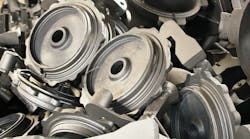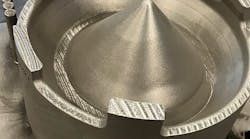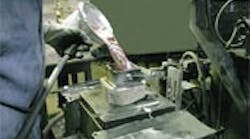By Peter B. Alpern
For decades, Oberdorfer L.L.C., an aluminum foundry in Syracuse, N.Y., has used shell sand to manufacture molds for its castings, which are mainly supplied to aviation industry manufacturers as cylinder heads for aircraft engines.
The shell sand process is quite common and well known to foundries: A heated metal pattern (or hot box) is coated with a mixture of sand and thermoset plastic. A very thin layer of the mixture adheres to the pattern, and this layer is removed from the pattern to form a “shell mold.” After the sand is cured, two shell molds are assembled together with any cores to form the casting mold. Molten metal is poured into the mold to form the final cast shape. Once the metal solidifies, the shell is broken and the finished casting is revealed.
The only notable problem with the shell process is the time needed to produce the sand molds.
What Oberdorfer L.L.C. has done is tweak the sand casting process — and it has found startling results. The company’s patent-pending Rock Shell process finishes its sand casting in a one-piece flow. Later, Oberdorfer uses recycled water pumped from cooling towers to cool the castings in a closed-loop system. In all, the foundry is making some notable progress in its time and energy saving efforts.
Shell sand molding is already recognized for its ability to produce complex parts, with good surface finishes and dimensional tolerances. Oberdorfer vice president of quality Jim LeRoy says its Rock Shell process improves the dimensional capabilities of the hot-box technique. “We put a little bit different degree of draft onto the pattern to pull it out of there as a ‘one-piece’,” he reveals, “where a lot of people would have to do it as a two-piece process.”
Conventionally, shell processes require heavy investments of time, as sand is heat treated, made into a mold, and then prepared for pouring hot metal. Oberdorfer’s Rock Shell technique makes it possible to speed up the process of making sand molds, so the entire production sequence is faster.
“We’ve improved that changeover with our continuous flow,” says LeRoy. “When we make a sand casting, I’m pouring within 20 minutes.”
According to Oberdorfer, the new process has increased its throughput of finished castings by between 85- and 97%, and reduced non-value activities by 30%. Finished quality has been improved, too, because the foundry streamlined nitrogen-degassing procedures with automatic controllers. (Nitrogen is used to draw










